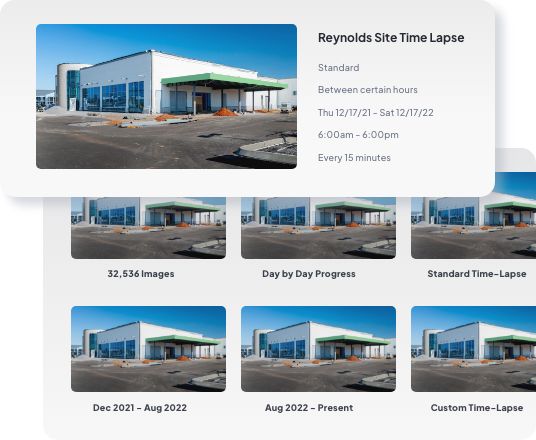Key Takeaways
- Long lead times for electrical and cooling systems require contracts during the design phase.
- Construction cameras and remote monitoring help smaller teams manage labor shortages.
- Automated, visual documentation helps prevent compliance gaps from becoming costly violations.
- Live jobsite monitoring aligns stakeholders and reduces disputes over scope and timelines.
Data center projects seem too big to fail, but they’re full of risks. A single hyperscale facility can cost upwards of $3 billion and take years to complete, supporting the cloud infrastructure that powers everything from streaming services to financial transactions.
When delays happen or missteps occur, the cost isn’t just financial. Projects can miss critical go-live dates, disrupt global connectivity, and damage long-term client relationships. Below, we explore the most common challenges plaguing data center construction and how top contractors are mitigating them with smarter planning and better visibility.
Common Data Center Construction Challenges
The path from groundbreaking to commissioning wouldn’t be complete without obstacles. Construction firms working on new data centers experience many of the following struggles.
Supply Chain Bottlenecks: The Race for Equipment
Global demand for data center infrastructure has created extreme demand for critical equipment. Electrical systems, cooling units, server components, and networking hardware are in short supply, with lead times that can stretch for months.
Risk factors:
- Long lead times for generators, switchgear, UPS systems, and cooling units
- Price volatility that can blow budgets mid-project
- Allocation constraints where manufacturers prioritize larger clients
The equipment you need might not arrive when you need it. And when it does, the price might have increased.
How to overcome it:
Secure procurement contracts early in the design phase, even before breaking ground. Maintain close communication with vendors to track shipment status and be ready for delays.
Verify delivery schedules with timestamped documentation so you have proof if disputes arise. Some contractors are using construction cameras to document deliveries as they arrive, creating a visual record that protects against vendor claims of late acceptance.
Labor Shortages: Finding (and Keeping) Qualified Workers
Hyperscale data centers require specialized trades, including electricians, HVAC technicians, IT specialists, network technicians, and low-voltage installers with experience in mission-critical environments. The problem? There aren’t enough of them.
- Competition from other mega-projects pulling from the same talent pool
- An aging workforce with limited training pipelines to replace retirees
- High turnover on long-duration projects spanning multiple years
When you can’t find qualified workers, schedules slip. When you find them but can’t keep them, quality suffers.
How to overcome it:
Partner with specialty staffing firms and trade organizations that focus on data center work. Consider off-site modular construction, where feasible, and utilize prefabricated components to minimize on-site labor needs and expedite timelines.
Many contractors are using construction cameras to reduce the need for constant onsite supervision, helping smaller teams do more. Remote live viewing gives project managers visibility into daily progress without burning hours commuting between jobsites. It’s not a replacement for boots on the ground, but it’s a force multiplier.

Compliance Gaps: Navigating Complex Regulations
Hyperscale data centers must comply with complex design standards, building codes, electrical requirements, environmental regulations, and energy-efficiency mandates, often across multiple jurisdictions.
Risk factors:
- Incomplete or outdated documentation that fails inspections
- Missed inspections that delay subsequent phases
- Code violations discovered late in construction, requiring expensive rework
One missed inspection can cascade into weeks of delays. One documentation gap can trigger a stop-work order.
How to overcome it:
Implement automated, visual documentation using construction cameras that capture key milestones as they happen. Time-stamped images and time-lapse footage of electrical installations, mechanical systems, and structural work create an audit-ready record.

A well-maintained and centralized digital platform makes it easy to manage approvals, so you’re not scrambling through emails and paper files when inspectors arrive. Additionally, your construction cameras with scheduled image capture provide continuous documentation without manual effort.
TrueLook captures a complete visual record of daily progress, aligning owners with GCs and reducing costly disputes. Contact us today to explore TrueLook’s solutions to jobsite visibility.
Stakeholder Misalignment: Avoiding Costly Disconnects
Data center projects involve a range of stakeholders, including project owners, engineers, general contractors, subcontractors, and equipment vendors. When these groups aren’t on the same page, miscommunication leads to rework, schedule slips, and finger-pointing.
Risk factors:
- Miscommunications between remote stakeholders who rarely visit the jobsite
- Disputes over scope, schedules, or deliverables that escalate into legal battles
- Lack of shared visibility into what’s actually happening on the ground
Everyone thinks they’re on the same page until they’re not. By then, it will be expensive to fix.
How to overcome it:
Unlock total project visibility with live jobsite monitoring. Give stakeholders access to real-time views of construction progress so everyone sees the same thing. Share progress visually with time-lapse videos and still images that document daily work. Visual proof reduces ambiguity and keeps conversations focused on facts rather than interpretations.
Scope Creep and Aggressive Timelines
Data center owners face relentless pressure to bring capacity online. Cloud providers need space for servers yesterday, and design changes flow in as technology evolves.
Risk factors:
- Constant design evolution that adds complexity mid-construction
- Unrealistic delivery expectations driven by market demand
- Blurred scope boundaries that make it hard to define “done”
When timelines are aggressive and the scope keeps shifting, something breaks. Usually, it is the schedule or the budget, or both.
How to overcome it:
Break down project milestones with clear scope boundaries. Define priority tasks before the next phase begins and obtain sign-off before proceeding. Use visual records to verify completed phases before transitioning teams to the next phase. A time-stamped image of a finished electrical room is harder to dispute than a verbal confirmation.
Communicate delays early using centralized tools. If a delivery slips or weather impacts the schedule, stakeholders need to know immediately, not in next week’s status meeting.
Outbuild the Risks With Better Visibility
Data center construction is getting easier, especially as construction teams learn best practices and technology improves. However, global demand continues to climb, and the complexity of these projects keeps increasing.
While the risk of data center construction isn’t going away, innovative firms are outmaneuvering challenges through better planning and unparalleled visibility. The contractors winning these project bids are the ones who can document progress, align stakeholders, and adapt quickly when roadblocks arise.
So, how do you overcome these construction challenges? Evaluate your own workflows. Are you relying on manual documentation that slows down the approval process? Are your stakeholders getting real-time visibility, or are they waiting for weekly reports?
The firms that answer “yes” to visibility and “no” to manual processes are the ones staying ahead.
Get the inside scoop on how leading contractors are using technology to manage complex builds, reduce risks, win bids, and deliver higher-quality projects on time. View the complete TrueLook Data Center Construction Guide and master these technological wonders.

